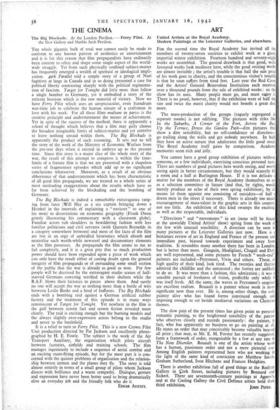ART
United Artists at the Royal Academy. Modern Paintings at the Leicester Galleries, and elsewhere.
FOR the second time the Royal Academy has invited all the members of twenty-seven societies to exhibit work at a giant impartial winter exhibition. Fourteen hundred and seventy-eight works are assembled. The general drawback is that good, well- favoured works look mediocre here, while the good retiring works are almost invisible ; the artist's trouble is that half the sale price of his work goes to charity, and the conscientious visitor's trouble is that he soon suffers from tired feet. Last year the Red Cross and the Artists' General Benevolent Institution each received over a thousand pounds from the sale of exhibited works: so the show has its uses. Many people must go, and must e4joy it There is no proof, however, that if the exhibition were of half the size and twice the merit charity would not benefit a great deal more.
The mass-production of the groups (vaguely segregated in separate rooms) is not edifying. The pictures with titles like In the Suburbs, A Corner of the Fort, Across the Bay, Up the Terrace, Down the Garden Path—dim pictures that show a dim sensibility, but no self-confidence or direction— go trailing along the walls and get nobody anywhere. In bulk they have an active nature that adulterates the little good stock The Royal Academy itself gains by comparison. Academy memories seem rich and jolly.
You cannot have a good group exhibition of pictures without someone, or a few individuals, exercising conscious personal taste. There are numbers of good pictures here worth seeing, and worth seeing again in better circumstances but they would scarcely fill a room and a half at Burlington House. If it is too delicate a matter for the members of the Royal Academy themselves to act as a selection committee in future Cand that, by rights, would merely produce an echo of their own spring exhibition), by all means let them appoint one consisting of outsiders—of half a dozen men in the street if necessary. There is already too much encouragement of mass-talent in the graphic arts in this country, not too little. An exhibition of this kind swamps the exciting, as well as the respectable, individuals.
"Directions" and " movements " in art (none will be found at the unwieldy United Artists' show) spring from the work of the few with unusual sensibility. A direction can be seen in many pictures at the Leicester Galleries just now. Here is a ininiature review of art in England and France of the present and immediate past, biassed towards experiment and away from tradition. It resembles many another there has been in London but is better than most. Gauguin, Modigliani, Chagall and Duly are well represented, and some pictures by French "week-end" painters are included—Peyronnet, Vivin and others. These, of high quality of their kind, look tired. The twenties and thirties admired the childlike and the untutored ; the forties are unlikely to do so. It was more than a fashion, this admiration ; it was a sensible pursuit of freshness of vision, profitable only while it was itself fresh. All the same, the waves in Peyronnet's seapiece are excellent realism. Rouault is a painter whose work is more significant now than ever. He is, among ,other things, the onlY painter alive who has found forms convinced enough and imposing enough to set beside mediaeval variations on Christian themes.
The slow pain of the present times has given point to personal romantic painting, to the heightened sensibility of the painter who observes closely and records passionately : the painter, in fact, who has apparently no business to go on painting at all. He states an order that may conceivably become valuable beyond all price ; that may, as Mr. E. M. Forster has recently suggested, form a framework of order, recognisable by a few at any rate in The New Disorder. Roault is one of the artists whose work has a human, passionate order and not a mere pictorial one. Among English painters represented here who are working in the light of the same kind of conviction are Matthew Smith Graham Sutherland, Ivon Hitchens and Frances Hodgkins.
There is another exhibition full of good things at the Redfern Gallery in cork Street, including pictures by Bonnard and Sicker*. There are seventeenth-century paintings at Agnew's, and at the Cooling Gallery the Civil Defence artists hold their


























 Previous page
Previous page